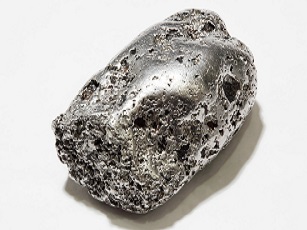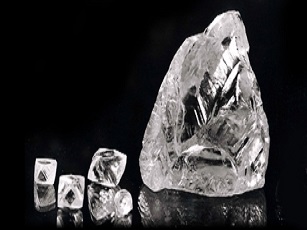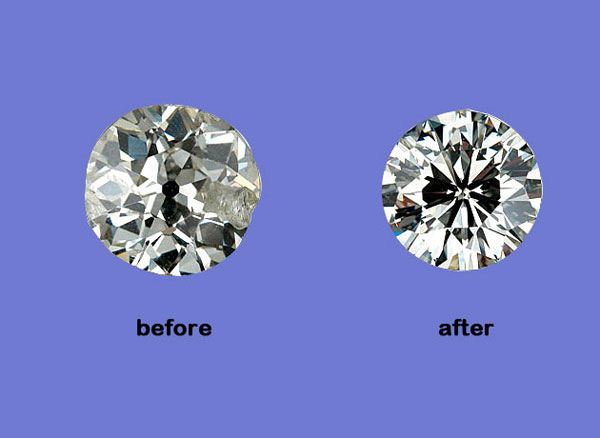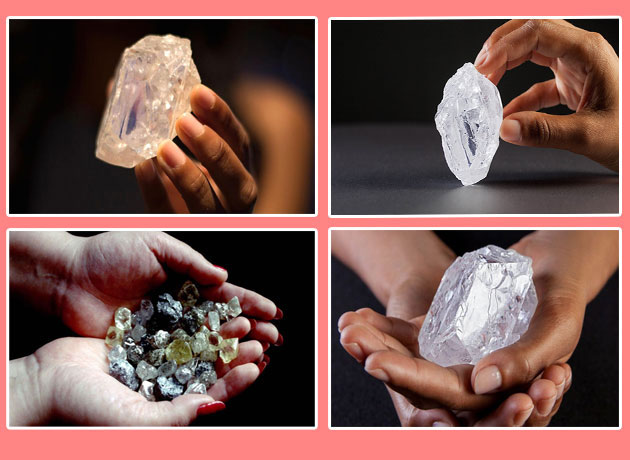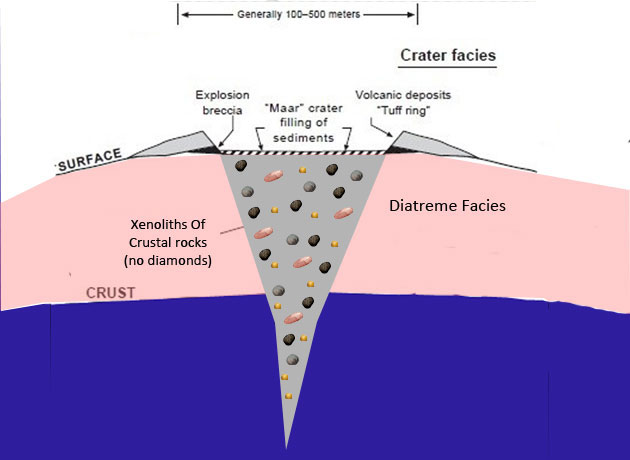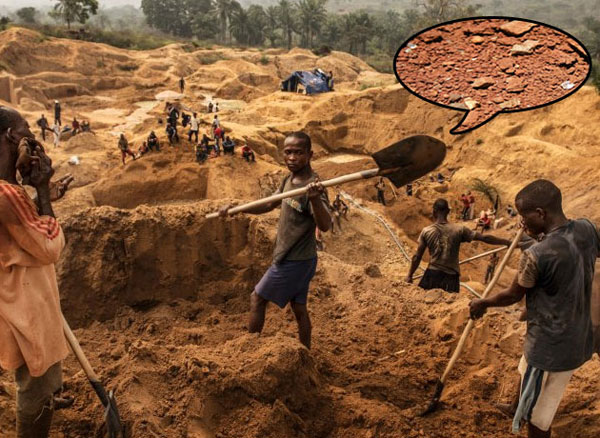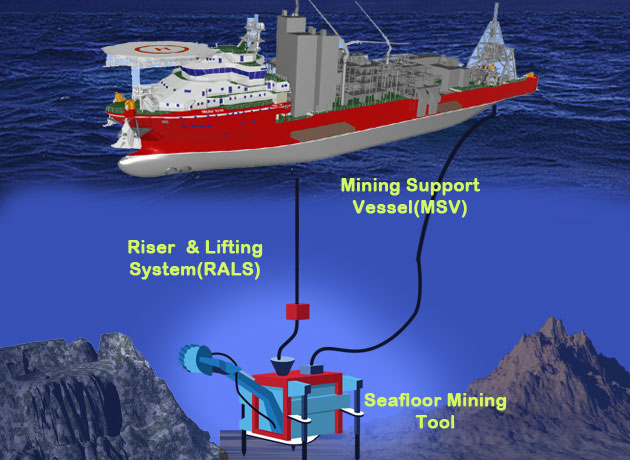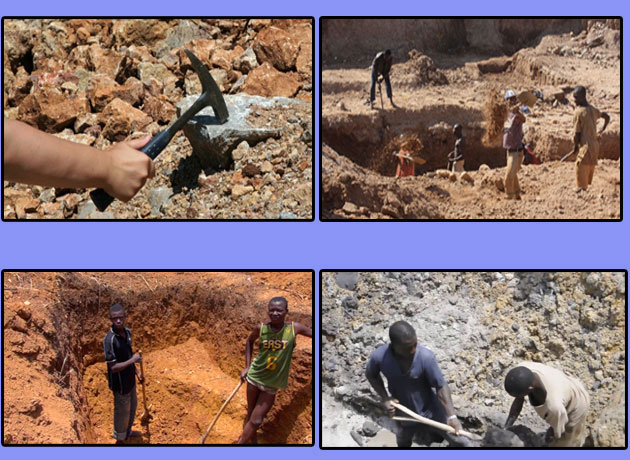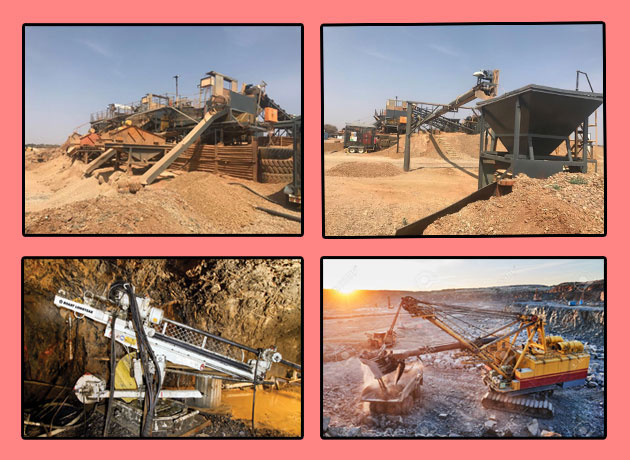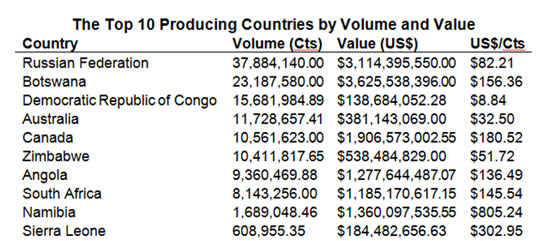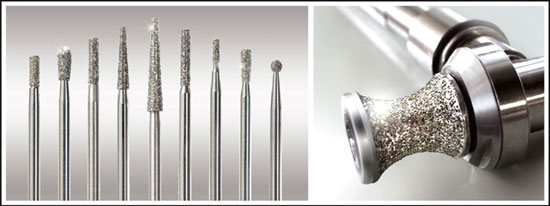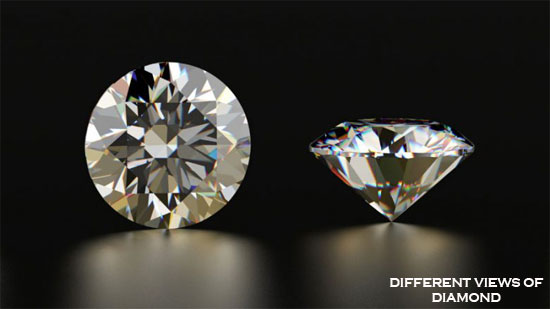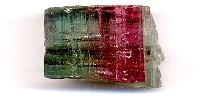Diamond Mining
DIAMOND MINING:
Mining is a foundational industry essential for extracting valuable minerals, metals, and other geological resources from the Earth's crust for various industrial, commercial, and societal purposes. This sector plays a crucial role in economic development, job creation, and technological advancements.
WHEN AND HOW DID IT APPEAR?
Diamonds have been valued and sought after for thousands of years due to their exceptional beauty and rarity. The appearance of diamonds dates back to an unimaginably distant history - back to the times when the Earth was still an incandescent celestial body. The exact time needed to form diamonds has not been precisely established, but it is estimated that the process may have lasted even several billion years.
Natural diamonds are formed when carbon is transformed from a gas into a liquid state at high temperatures and under enormous pressure, and then crystallized by cooling. According to scientific measurements, diamonds appear in extreme conditions when the pressure reaches over 70,000 kg/cm², and the heat ranges from 1000°C to 1300°C, which corresponds to conditions in the depths of around 150-250 km below the Earth's surface.
DIAMOND MINING PROCESS:
Diamond mining is a complex process involving multiple stages, from exploration and discovery to extraction, processing, sorting, and distribution. Here's an overview of the diamond mining process:
- Exploration:
- Kimberlite Discovery:
- Mining Methods:
- Diamond Processing:
- Sorting and Grading:
- Marketing and Distribution:
- Ethical and Environmental Considerations:
- Certification and Traceability:
Diamond mining begins with geological surveys, aerial photography, and satellite imagery to identify potential diamond-rich areas. Geologists and prospectors look for geological indicators like kimberlite and lamproite pipes, volcanic rock formations that often contain diamonds. Core drilling and sampling confirm the presence of diamond-bearing rocks.
Once a potential area is identified, drilling core samples are analyzed to assess the diamond content and quality of the kimberlite rock.
Primary diamond mining methods include: 1.Open-Pit Mining: Used when the diamond-bearing kimberlite pipe is near the surface. Overburden and rock layers are removed to expose the kimberlite for processing. 2.Underground Mining:Employed when the kimberlite pipe is deeper. Techniques include block caving, sublevel caving, and vertical shafts. 3.Alluvial Mining: Used for diamonds found in riverbeds and sedimentary deposits. Methods include dredging, panning, and sluicing to extract diamonds from loose sediment.
The diamond-bearing rock undergoes several stages at processing plants:
Crushing: Liberates diamonds from the kimberlite.
Screening: Separates diamond-rich material from waste rock and other minerals.
Scrubbing: Further liberates diamonds through scrubbing.
X-ray Sorting: Uses advanced technology to identify and separate diamonds based on their unique X-ray characteristics.
Extracted diamonds are sorted and graded based on size, color, clarity, and shape by expert gemologists.
Sorted and graded diamonds are sold to dealers, manufacturers, and jewelry companies. After cutting and polishing, they are distributed worldwide for various industries, primarily jewelry manufacturing.
Ethical sourcing, environmental protection, and responsible mining practices are crucial in the diamond industry. Efforts to minimize environmental impact and ensure community well-being are prioritized.
Diamonds undergo certification and traceability to ensure ethical sourcing and authenticity. The Kimberley Process Certification Scheme aims to prevent the trade in conflict or "blood" diamonds.Diamond mining is a highly regulated industry focused on ethical practices and sustainability. Technological advancements and responsible sourcing are vital for ongoing development.
STANDARD METHODS FOR DIAMOND MINING:
The standard methods of mining for diamonds include a range of techniques and processes, each suited to different geological conditions and the depth at which diamonds are found. Here are the standard methods commonly used in diamond mining:
- Open-Pit Mining
- Underground Mining
- Alluvial Mining
- Marine Mining
- Artisanal and Small-Scale Mining (ASM)
Mining Method for Primary Deposits
Open-Pit Mining
When the primary deposit is located near the surface, open-pit mining is commonly used. This method involves the removal of overburden (soil, rock, and other materials) to expose the kimberlite pipe. The exposed kimberlite is then processed to extract diamonds.
Underground Mining
Underground mining techniques are employed when diamond-bearing kimberlite pipes are located deeper underground. Various methods can be used in underground mining, including block caving, sublevel caving, and vertical shafts. These techniques involve creating tunnels and chambers to access the kimberlite pipes, followed by extraction and processing.
Mining Methods for Secondary Deposits
Alluvial Mining
Alluvial deposits are found in riverbeds and sedimentary environments. Miners use various techniques, such as dredging, panning, sluicing, and dry digging, to extract diamonds from loose sediment. Over thousands of years, the kimberlite pipe that reaches the Earth's surface is eroded and weathered by wind, rain, rivers, and streams. The eroded kimberlite bears rough diamonds, which are carried downstream.
The first diamonds discovered in South Africa were from alluvial deposits. Today, industrial alluvial mining involves building a large wall to collect the water in one area. Diamonds are often found in the gravel layer, which collects under layers of other material, such as mud, clay, and underwater plant life. Once the gravel is collected, it is hauled to the surface and prepared for processing.
Marine Mining
Marine deposits are found on the ocean floor, often in offshore locations. Specialized vessels and equipment, such as dredging systems and subsea robots, are used to recover diamonds from underwater deposits. Marine mining involves extracting diamonds from the seabed, hundreds of meters underwater. The earliest form of marine mining entailed shore diving, where a swimmer would collect diamond-bearing gravel from the shallow seabed.
Today, technology has evolved to specialized ships that mine for diamonds deep out at sea. These specialized ships use a powerful crawler that sucks gravel on the seabed up through flexible hoses/pipes. Alternatively, they use a large-scale drill mounted to the ship to excavate diamonds. The coast of Namibia is the richest known source of marine diamond deposits, which account for approximately 64% of Namibia's total diamond production.
Processing of Ore to Extract Rough Diamonds
- Stage 1 - Crushing
- Stage 2 - Scrubbing
Once the diamond bearing ore and gravel is collected, it is transported to a primary crusher. The primary crusher is responsible for reducing the size of the ore into smaller, more manageable pieces or chucks measuring no larger than 150mm. A secondary crusher, known as a roll-crusher, may also be used to reduce the size of the ore even further.
In this stage, the ore are scrubbed to remove loose excess material and is screened. Material smaller than 1.5mm is discarded because it is too costly to extract diamonds from such a small piece of ore.
- Stage 3 - Cyclonic separation plant
- Stage 4 - Recovery
- Stage 5 - Cleaned, weighed and packaged
During this stage the diamond bearing ore is mixed with a solution of ferrosilicon powder and water, which is measured to a specific relative density. This solution is fed into a cyclone, which tumbles the material and forces a separation. Materials with a high density sink to the bottom, which results in a layer of diamond rich concentrate.
Here, the diamond rich concentrate is put through a series or processes involving magnetic susceptibility, X-ray luminescence and crystallographic laser fluorescence that are calculated based on the specific properties of diamonds. These processes are designed to separate the rough diamond from any other heavy density materials collected by the cyclonic separation plant. For example, diamond's fluorescence when exposed to an X-ray. Sensors detect flashes of light emitted by the diamond and send a signal to a microprocessor that fires a blast of air at the diamond, which spits it into a collection box.
The diamonds collected in the recovery process are cleaned in an acid solution, washed, weighed and packaged in sealed containers for transport. In accordance with the Kimberley process, these containers are sealed with a tamper resistant seal, numbered on site, and a certificate of origin is issued.
Diamond Producing Countries :
Producing countries are countries where diamonds are found and mined. There are two major bands around planet Earth, the northern band and the southern band. A third center band also has diamonds but of lower quantity and value. The Northern band includes Russia and Canada, two of the leading diamond-producing countries. The Southern band includes Southern African states such as Botswana, South Africa and Namibia, as well as Australia. The center band includes the Ivory Coast and Sierra Leone in Africa, and Venezuela and Brazil in South America. The top five producing countries by volume of production are Russia, Botswana, the Democratic Republic of Congo (DRC), Australia and Canada.
RUSSIA
The Mir mine also called the Mirny mine, is an open pit diamond mine located in Mirny, Sakha Republic, in the Siberian region of eastern Russia. The mine is 525 metres deep (1722.44 feet) and has a diameter of 1,200 m (3,900 ft). The Mir mine was the first developed and the largest diamond mine in the Soviet Union. Its surface operation lasted 44 years, finally closing in June 2001. After the collapse of the USSR, in the 1990s, the mine was operated by the Sakha diamond company, which reported annual profits in excess of $600 million from diamond sales.
Later, the mine was operated by Alrosa, the largest diamond producing company in Russia, and employed 3,600 workers. However, in 1970s construction of a network of tunnels for underground diamond recovery began.
By 1999, the project operated exclusively as an underground mine. In order to stabilize the abandoned surface main pit, its bottom was covered by a rubble layer 45 metres thick. After underground operations began, the project had a mine life estimate of 27 years, based on a drilling exploration program to a depth of 1,220 meters.
In the 1960's the mine was producing 10,000,000 carats (2,000 kg) of diamond per year, of which a relatively high fraction (20%) were of gem quality. The upper layers of the mine (down to 340 metres) had very high diamond content of 4 carats (0.80 g) per tonne of ore, with the relatively high ratio of gems to industrial stones. The yield decreased to about 2 carats (0.40 g) per tonne and the production rate slowed to 2,000,000 carats (400 kg) per year near the pit bottom.
BOTSWANA
The Jwaneng diamond mine is the richest diamond mine in the world and is located in south-central Botswana about 120 kilometers (75 mi) west of the city of Gaborone, in the Naledi river valley of the Kalahari. Jwaneng is owned by Debswana, a partnership between the De Beers company and the government of Botswana. It is the second newest of four mines operated by the company, having begun operations in 1982.
Jwaneng is an open pit mine. The mine produces 9.3 million tons per year of ore and an additional 37 million tons per year of waste rock. The mine is located on three kimberlite pipes that converge near the surface, covering 520,000 square metres at ground level.
Currently, the mine produces approximately 11 million carats (2,200 kg) of diamonds. The recoverable ore grade at the mine is about 1.25 carats per ton (250 mg/t). As of 2005, known reserves will allow production at current levels to continue for 27 years. The high rate of diamond extraction, combined with high quality diamonds fetching excellent per weight prices, make the Jwaneng diamond mine the richest diamond mine in the world by value of recovered diamonds. Jwaneng employs over 2,100 people. At the center of the diamond mine, a series of concentric circles cut deeper and deeper into the ground. Surrounding the pit is a network of roads and structures related to the mining operation.
INDIA
Diamond mining in India extends back into antiquity. From ancient times, India was the source of nearly all the world's known diamonds, and until the discovery of diamonds in Brazil in 1726, India was the only place where diamonds were mined. India has not been a major diamond-producing country since the 1700's, but diamond mining continues. In 2013, India mined 37,515 carats of diamonds, from one industrial-scale mine and many artisanal mines; this was less than one-tenth of one percent of the world production of 132.9 million carats.
Recent Mining in Patna Region (Bundelkhand):
As of 2017, there was one industrial-scale diamond mine in India, the Majhgawan mine, near the town of Panna, Madhya Pradesh. The deposit is in a kimberlite or lamproite pipe 6.5 ha in area, and yields 10 carats to the ton. Mining is done by an open pit, which was 85 m deep as of 2011. Exploration drilling has established that the pipe continues down to at least 330 m. The mine is owned by the National Mineral Development Corporation (NMDC), employs 199 people, and has a productive capacity of 84,000 carats per year. The mine began regular production in 1967, and to date, has yielded slightly more than a million carats of diamonds.
There are also numerous artisanal-scale mines. In the Panna mining district, the Madhya Pradesh government leases 8x8m plots to individuals, who wash the gravel for diamonds.
All diamonds found are required to be handed over to the government diamond office in Panna, which markets the gems, and gives the sales proceeds to the finders, less taxes and 11.5 percent royalty. In 2016, there were officially 952 artisanal mines, which yielded 835 carats of diamonds. However, there is an unknown number of small illegal mines, and an unknown amount of diamonds sold on the black market. The Rio Tinto Group discovered the Bunder diamond deposit in 2004 in Chhatarpur district near Buxwaha. The deposit is in an ecologically sensitive area. In February 2017, Rio Tinto quit work on the project, and gave the deposit and all on-site equipment to the state government of Madya Pradesh.
USES OF DIAMOND :
When people think of diamonds, they tend to think of jewelry, such as rings, earrings, or necklaces. However, as the hardest naturally occurring substance on the planet, diamonds are used for many other unknown purposes.
Speaker Domes : Diamonds are believed to actually enhance the performance of high quality speakers. Because diamonds are a very stiff material, they can vibrate rapidly when made into a thin dome without the deformation that can degrade sound quality.
Antidote for Poison/Disease : While there is no scientific evidence backing this usage, diamonds are often used as antidotes in various places for poisons or diseases. The belief that swallowing diamonds would ward off illness stems from the days of the plague.
Abrasives : Because diamonds are so hard and durable, they are ideal for grinding, cutting, drilling, and polishing. When used as an abrasive, very small pieces of diamond are embedded into grinding wheels, saw blades, or drill bits.
Heat Sinks : A heat sink is a passive component in an electronic system that cools a device by dissipating heat into the surrounding air. Diamonds have very high thermal conductivity, which means they are excellent heat conductors. Because of this, diamonds are used as a material for heat sinks.
Engraving : Diamonds are used for the engraving of stones made of granite, quartz, and other very hard materials. Because diamonds will not break or even scratch against the surfaces of other tough stones, using them for engraving is quite practical as the work can be completed without having to worry about replacing the engraving bit.
Potential Future Uses : In the future, diamonds may be used for surgical tools, medical devices, and prosthetic human joints. Research is being conducted into whether or not the Earth's hardest naturally occurring substance could be of any use to the medical community.
Related Mining
`
